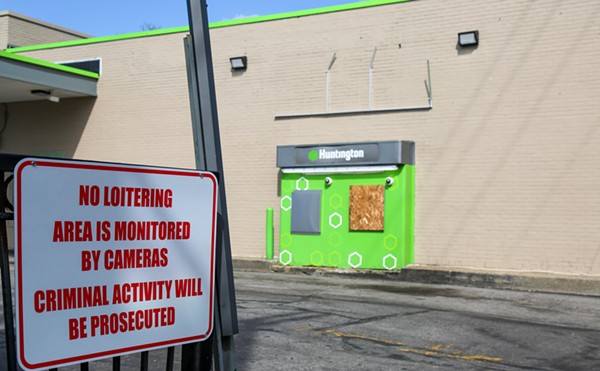A breeze skips off the river, raking the near-fossilized trash and crumpled glossy club flyers littering the sidewalk on Old River Road. In terms of real estate, the street is a heap of dead bodies, the empty storefronts casualties of the East Bank's abrupt nosedive years back. But tonight, muffled behind the doors of Earth Nightclub, a pulse of bass knocks around inside.
The club — once the dingy Odeon, now upgraded with a lush vibe — has all the extra fixings tonight: the high-heeled girls up front wave around handfuls of general admission and VIP bracelets; guys in earpieces dart around checking names off clipboards. On the normally bare stage stand three six-by-eight video screens framed by trusses strung with lights; as the dance floor below fills up and the clock eats up what's left of Thursday evening, the displays flash through the names of the rotating line-up behind the turntables, a Who's Who of the city's best known DJs: Alex Kay, Corey Grand, Flaco Flash, Pana, Donkis, and tonight's birthday boy, E-V.
One after the other they take the stage, hauling up sticker-covered Mac Books before free-jazzing their way through a set, blending this old-school rap track with that '80s pop tune, suturing an electro outro onto a chart topper — basically stringing together a single night-long piece of ear theater that keeps enthusiastic arms and legs constantly moving. And more people want in. Out front, an anxious line is strung down the street all evening.
The night hits its climax when E-V brings out a special guest: Machine Gun Kelly. The cameo makes complete sense. E-V regularly opens for the Cleveland rapper on tour; a number of the DJs in tonight's lineup remix MGK material. It's just two examples of the cross-pollination between the guys cutting the records and the ones playing them in clubs and on the radio.
But instead of lint collecting on the hip-hop scene's coattails, Cleveland's class of DJs stands out on its own: a field thick with artists who are cutting their own course and inking their own reputations. And in a city that prides itself on its musical heritage, a well-known DJ probably has more name recognition these days than any of the bands or singer-songwriters working what's left of the traditional music scene.
"Cleveland just breeds good DJs," says Keenan Williams — DJ K-Nyce — a week later while walking the halls of Z107.9, the radio station that hosts his daily show. "This hustling-ass city. We're gonna make something out of nothing."
Yet despite how far the homegrown scene has come, Cleveland might not be the best place for DJs to flourish.
••••••••••••••••••••••••••••••••
DJs get a bad rap as human iPods who simply hit play on the next no-brainer Top 40 hit. Over the past couple of years, more critical respect has been meted out to the craft, mainly thanks to high-profile names like Diplo, Skrillex, and A-Trak, spinners who've emerged as their own artists.
On any level, DJing is a multi-dimensional job — especially live, when the mixer is a combination music arranger and cruise director. Instead of simply fading the previous tune out at the start of the next, a DJ welds the two together. Technically speaking, you can splice the DNA of even two wildly different songs, although you might have to get creative in how you merge the two.
It's advice that's stuck with Nate Wachsman — DJ Donkis — since the beginning. Working the night shift at hip-hop station Z107.9 years back, Donkis would mess around on the turntables, trying to learn. One night, then-Cleveland DJ Mic Boogie walked into the studio and handed over a useful challenge.
"He would come in and there was a crate of random records sitting there," Donkis recalls. "He would say, 'If you can mix this whole crate of records without stopping or changing the beat, then you know what you're doing.'
"It took me awhile, but I know exactly what he means now. All songs can go together in some way, no matter what. They might not be the songs you want to mix together right then, but you can get there in two or three songs. Say you want to take a Hall & Oates track and put a hip-hop track to it. If they don't match, it will take me two or three songs to figure out how to get there."
At the level of nuts and bolts, DJs entwine songs by carefully getting inside the sonic guts of each track. Every musical beat has a kick and a snare; the catch is to link the two on the fly.
"If I have something that's 70 beats per minute, and I want to mix in something that's 68 beats per minute," explains K-Nyce, "on the turntable I will literally slide up two notches, match up the kicks and the snares. I hold one snare, time it to drop when the next one drops, and then the beats in theory should be on point."













